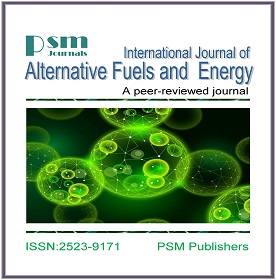Recent Trends in Animal Fats and Oils to Biodiesel Research: Conversion Methods, Technical Challenges and Assessment of Economic and Environmental Impacts
Keywords:
Biodiesel, Renewable energy, transesterification reaction, animal fats, oilsAbstract
Changes in climate due to the enormous amount of carbon dioxide emissions have really encouraged the development of energy sources that are renewable, sustainable, and eco-friendly (Alajmi et al., 2017). In the last few years, biodiesel has emerged as one of the most potential renewable energy to replace current petrol-derived diesel. It is a renewable, biodegradable and non-toxic fuel which can be easily produced through transesterification reaction especially alkali-catalyzed transesterification (Leung et al., 2010). Triacylglycerols (fats and oils) are converted into esters by transesterification reaction producing three smaller molecules of ester and one molecule of glycerin from one molecule of fat or oil. Glycerin is removed as by-product and esters are known as biodiesel (Fazal et al., 2011). Sustainable alternatives for biodiesel production are being researched with the use of enzymes; enzymatic transesterification has attracted much attention for biodiesel production as it produces high purity product and enables easy separation from the byproduct, glycerol. (Ranganathan et al., 2008). The development of alternative energy sources can also be attributed to the rapid decrease in resources of fossil energy. Although, most studies regarding the use of animal wastes as feedstock in biodiesel production are still in the early stages and have not focus on the recent advances in the use of animal fats waste (Alajmi et al., 2017).
Biodiesel is attracting an increasing deal of attention worldwide for it is currently the only renewable energy carrier which could directly replace diesel fuel in compression ignition engines because of its positive cumulative energy values when compared to petroleum-derived diesel (Vonortas and Papayannakos, 2014). In their study, Tabatabaei et al. (2015) documented the recent innovations in biodiesel production which are presented under three categories of upstream, mainstream, and downstream processes.
Among the many challenges yet to be overcome before one could portray biodiesel as a sustainable alternative for decades to come is an economic feedstock supply. In fact, it is now well-documented that the price of feedstock could account for 70-88% of the total biodiesel production cost and hence is considered as the most significant factor affecting the economic viability of the biodiesel market (Hasheminejad et al., 2011). Non-edible feedstocks such as animal fat wastes (AFWs) have recently increased in popularity as alternatives to vegetable oils in the production of biodiesel. They are low cost, mitigate environmental damage and increase the quality of the resultant biodiesel fuel (low NOx emissions, high Cetane number and oxidative stability) (Adewale et al., 2015). The main challenging issue is its high free fatty acid (FFA) content. In fact, it has been reported that biodiesel yield could drop down to 6% when the FFA content increases just above 5% wt. (Moser, 2011). The most current biodiesel synthesis processes cannot handle feedstock with high FFA content; it was proved that the supercritical fluid process can result in a significant advantage for feedstocks with any fatty acid content (Yang, 2004).
An alternative fuel to petrodiesel must be technically feasible, economically competitive, environmentally acceptable and easy available (Demirbas, 2009). FAME from vegetable oils and animal fats have shown promise as biodiesel, due to improved viscosity, volatility and combustion behaviour relative to triacylglycerols, and can be used in conventional diesel engines without significant modifications (Bhatti et al., 2008).
The advantages of biodiesel over diesel fuel are its portability, ready availability, renewability, higher combustion efficiency, lower sulphur and aromatic content, higher cetane number, higher biodegradability, better emission profile, safer handling, besides being non-toxic (Lapuerta et al., 2008; Demirbas, 2009). Moreover, biodiesel offers advantages regarding the engine wear, cost, and availability. When burned, biodiesel produces pollutants that are less detrimental to human health (Fazal et al., 2011).
Usage of biodiesel will allow a balance to be sought between agriculture, economic development and environment (Demirbas, 2009). Lower cost feedstocks are needed since biodiesel from food-grade oils is not economically competitive with petroleum-based diesel fuel.







